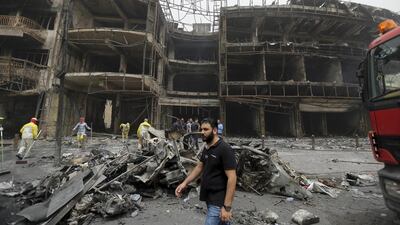BAGHDAD // Dozens of men were watching a soccer match at the Smile cafe when a bomb blast hit in the street below. Within minutes, a fire trapped them on the second floor of the Baghdad shopping mall where they had gathered.
There were no fire exits, no firefighters. An iron gate to the roof was padlocked.
One of those watching the match, Majid Toamah, kicked a hole in an aluminum wall in the cafe and leaped 20 metres to the alley below. The 40-year-old, who broke both his legs, looked up to see terrified faces staring out of the hole.
“They were too scared to jump. The face of one of them caught fire,” Mr Toamah remembered. “In the end, they all died.”
Two hundred and ninety-two people died from the July 3 car bombing in Baghdad’s central Karradah district. Most of the deaths resulted not from the blast itself, but from the ensuing fire, fed by a tinderbox of shops in two malls filled with clothing and oil-based perfumes for sale and lined with flammable panels.
A slow response by firefighters, building code violations and a lack of water made matters worse.
As a result, two three-storey shopping malls separated by a broad avenue and several other buildings were burned to their skeletons. It was the deadliest attack by a single bomber since Iraq’s war began in 2003, with the toll likely to rise further as authorities struggled to identify human remains.
“We are still sifting through the debris,” civil defence member Mustafa Khudair Hamad said days after the fire. He said “remains are still coming out”.
Hassan Abdul Zahra, who worked at a women’s clothing store near the blast site, recalled listening to screams for help from people trapped in the malls.
Public grief has been stoked by anger over deeply rooted corruption and inefficiency that may have cost lives.
State civil defence forces, under heavy criticism, blamed the absence of safety standards.
“The culture of safety measures is almost zero in Iraq,” Brig Gen Kadhim Bashir Saleh of the civil defence force said. “Some investors do not care about applying safety standards in their projects to keep the costs low and even store owners do not consider buying fire extinguishers.”
He said the two malls, the Hadi and Laith centres, lacked emergency exits and stairs, sprinklers and fire hoses and had “unprofessional wiring”. Authorities had previously issued a warning to the owners of both malls, he said, and after getting no response, they filed a court case against them.
If the buildings had proper safety standards, the death toll would have been exponentially lower, said a Baghdad-based engineer, Mohammed Hadi Hussein.
“In today’s Iraq nothing can stop violations, thanks to corruption,” said Mr Hussein, who owns the Land of Engineering and Planning company. “The law is there and clear, but corruption is also there.”
He could not speak of the two malls, but said construction companies often submit maps to authorities that have been drawn to standards, but then change them in the actual building to cut costs.
In a sign of how deeply felt the horror is over the Karradah blast, the site has been turned into a makeshift shrine, a rare memorial in a city of seven million that has seen countless bombings over the years.
* Associated Press

